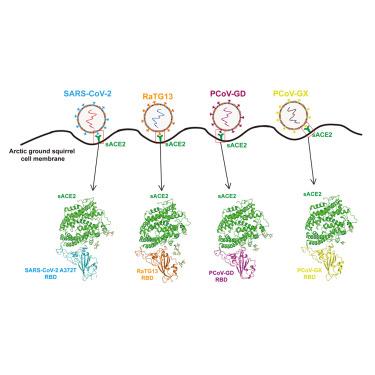SARS-CoV-2、RaTG13、PCoV-GD和PCoV-GX受体结合域对松鼠ACE2的跨种识别
IF 4.3
2区 生物学
Q2 BIOCHEMISTRY & MOLECULAR BIOLOGY
引用次数: 0
摘要
SARS-CoV-2具有广泛的动物宿主范围,但其起源和中间宿主仍存在争议。北极地鼠ACE2 (sACE2)可与SARS-CoV-2和RaTG13的RBDs结合,并支持SARS-CoV-2和RaTG13假病毒粒子的转导,证明北极地鼠是SARS-CoV-2和RaTG13的易感动物宿主。在这里,我们确定了与RaTG13、PCoV-GD、PCoV-GX、SARS-CoV-2 A372T和SARS-CoV-2 JN.1变体的rbd结合的sACE2的晶体结构。SPR分析表明RBD残基493、498和501可能是sACE2识别的重要基因。值得注意的是,sACE2的n322链聚糖被发现与RaTG13 RBD的S375接触。此外,最近的SARS-CoV-2 KP.2和KP.3变体rbd也可以与sACE2结合。我们的研究结果进一步揭示了冠状病毒RBD与细胞受体ACE2之间的相互作用,这可能有助于我们对SARS-CoV-2进化的理解。本文章由计算机程序翻译,如有差异,请以英文原文为准。

Cross-species recognition of squirrel ACE2 by the receptor binding domains of SARS-CoV-2, RaTG13, PCoV-GD and PCoV-GX
SARS-CoV-2 has a broad animal host range, but its origin and intermediate hosts are still debated. Arctic ground squirrel is proved to be a susceptible animal host of SARS-CoV-2 and RaTG13, as the Arctic ground squirrel ACE2 (sACE2) could bind to the RBDs of SARS-CoV-2 and RaTG13, and support transduction of the SARS-CoV-2 and RaTG13 pseudovirions. Here, we determined crystal structures of sACE2 bound to the RBDs of RaTG13, PCoV-GD, PCoV-GX, SARS-CoV-2 A372T and SARS-CoV-2 JN.1 variant. SPR assay indicated that RBD residues 493, 498 and 501 might be important for sACE2 recognition. Notably, N322-linked glycans of sACE2 were found to be in contact with S375 of the RaTG13 RBD. Moreover, the recent SARS-CoV-2 KP.2 and KP.3 variant RBDs could also bind to the sACE2. Our results provide further insights into interactions between coronavirus RBD and cell receptor ACE2, which may promote our understanding of SARS-CoV-2 evolution.
求助全文
通过发布文献求助,成功后即可免费获取论文全文。
去求助
来源期刊

Structure
生物-生化与分子生物学
CiteScore
8.90
自引率
1.80%
发文量
155
审稿时长
3-8 weeks
期刊介绍:
Structure aims to publish papers of exceptional interest in the field of structural biology. The journal strives to be essential reading for structural biologists, as well as biologists and biochemists that are interested in macromolecular structure and function. Structure strongly encourages the submission of manuscripts that present structural and molecular insights into biological function and mechanism. Other reports that address fundamental questions in structural biology, such as structure-based examinations of protein evolution, folding, and/or design, will also be considered. We will consider the application of any method, experimental or computational, at high or low resolution, to conduct structural investigations, as long as the method is appropriate for the biological, functional, and mechanistic question(s) being addressed. Likewise, reports describing single-molecule analysis of biological mechanisms are welcome.
In general, the editors encourage submission of experimental structural studies that are enriched by an analysis of structure-activity relationships and will not consider studies that solely report structural information unless the structure or analysis is of exceptional and broad interest. Studies reporting only homology models, de novo models, or molecular dynamics simulations are also discouraged unless the models are informed by or validated by novel experimental data; rationalization of a large body of existing experimental evidence and making testable predictions based on a model or simulation is often not considered sufficient.
 求助内容:
求助内容: 应助结果提醒方式:
应助结果提醒方式:


